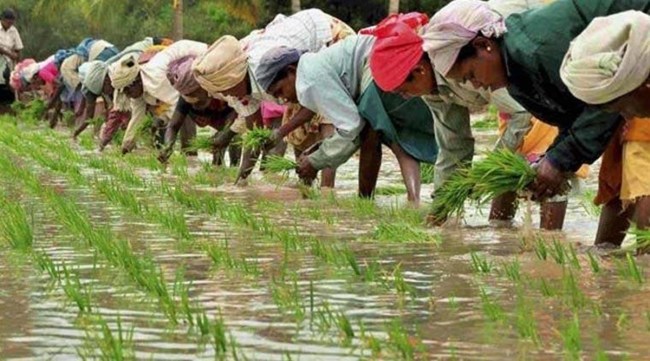Opinion Ajay Vir Jakhar on Budget 2023: There is no out-of-the-box thinking on farm sector
The allocations are minuscule, even for programmes to incentivise natural farming, using animal manure and shifting to alternative fertilisers
 "The Pradhan Mantri Kaushal Vikas Yojana that aims to skill 4 lakh youth within the next three years brings to mind Lao Tsu’s words, “The truth is not always beautiful, nor beautiful words the truth," writes Ajay Vir Jakhar. (File)
"The Pradhan Mantri Kaushal Vikas Yojana that aims to skill 4 lakh youth within the next three years brings to mind Lao Tsu’s words, “The truth is not always beautiful, nor beautiful words the truth," writes Ajay Vir Jakhar. (File) One is relieved that India has avoided what has happened in the country’s neighbourhood —Pakistan, Bangladesh and Sri Lanka. Having looked at the past seven budgets, Ursula K Le Guin’s words ring true: “There is a certain bleakness in finding hope where one expected certainty.” With elections to the state assemblies and Parliament slated over the next year or so, the Union budget was expected to be populist within the constrained fiscal circumstances.
It does far more.
In layman’s terms, how do the budget allocations impact farmers? Indian farmers pay Rs 266.50 per bag of urea with a subsidy per bag of Rs 2,317. For DAP, they pay Rs 1,350 per bag with a subsidy component of Rs 2,500. Farmers generally use five bags of urea and two-and-a-half bags of DAP per acre for a wheat-paddy crop rotation. Therefore, they are subsidised to the tune of Rs 17,840 per acre. Their Pakistani brethren pay 2.5 times this amount. The BJP IT cell could have saturated the online conversation with this positive narrative, but it was busy creating ghosts. This has resulted in the FM being compelled to make compromises.
Yet, it would be worthwhile to ask if India is going wrong somewhere. On my field trips across the country, I asked farmers and landless workers if 75 years of budgets, agriculture policies, support and subsidies have empowered them to lead a life of dignity. The answer is always a vehement “no”. Governments provide humongous sums (over Rs 8 lakh crore) under PM Kisan, free electricity, subsidised fertiliser and minimum support price procurement. It is not that India has not progressed or these subsidies have not helped but, after 75 years, something is seriously amiss. The answer, which curiously even farmers seem unconscious of, is that most subsidies are only a “pass-through” to consumers and cash transfers are a simplistic fix for inherently complex issues.
There is also confusion when it comes to apportioning blame. The Centre receives flak for lack of delivery of services and promises that are actually within the ambit of the states. At the state level, the capacity to deploy resources rationally — to scale up and execute programmes — remains abysmally low. Thus, one simply cannot forecast the future by poring over the Union budget in isolation from what will happen at the state level. Ideas like reviving the “old pension scheme” and providing “free electricity” can only hasten bankruptcy in the states that resort to such measures. The other worry is the booming debt — at the Centre and state levels — which the budget fails to stem. In fact, India’s debt is growing faster than the economy as a whole.
Till some time ago, the conventional wisdom was: Budgetary allocations can be made on the premise that quality of life can be equated with consumption. But that is now being questioned. Budget 2023 seems to be aware of this shift. Allocations for 11.7 crore household toilets under the Swachh Bharat Mission and enhancing the outlay for PM Awas Yojana by 66 per cent to Rs 79,000 crore are welcome steps. As a farmer, one is excited about the Atmanirbhar Horticulture Clean Plant Programme to boost the availability of disease-free, quality planting material — the programme has an outlay of Rs 2,200 crore. The budget makes a good effort but considering the size of the farm sector, the allocations are minuscule, even for programmes to incentivise natural farming, using animal manure and shifting to alternative fertilisers.
Contrary to expectations, the FM has decided not to increase the quantum and ambit of PM Kisan to farm labourers. The bigger worry is on the employment front. The government has failed in filling government job vacancies and generating employment. I do not foresee the creation of mass employment fast enough or raising of incomes, except for government employees.
The Pradhan Mantri Kaushal Vikas Yojana that aims to skill 4 lakh youth within the next three years brings to mind Lao Tsu’s words, “The truth is not always beautiful, nor beautiful words the truth”. The words “green” and “energy” occur several times in the budget speech. They raise apprehensions that the funds will be spent on industrial-scale projects for converting food to fuel — a terrible proposition. The green transition is better achieved by incentivising electric tractors, charged with on-field solar panels and giving farmers the choice of being off-the-grid or with a net-metering facility. Out-of-the-box thinking seems to be missing from the budget.
For those wondering if the budget will move the needle one way or another, one can only advise a potion of blind faith. The decade is still not lost. As a farmer, one is an optimist, as farmers usually are. Despite all the reasons for pessimism, there is hope that the worst is behind us, though one does not really know what lies ahead. The economic reality is catching up with this regime and it is time the lion lost sleep over the opinion of the sheep.
The writer is chairperson, Bharat Krishak Samaj





